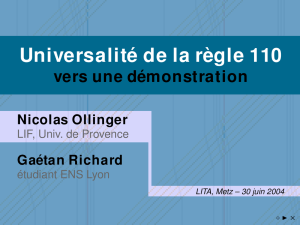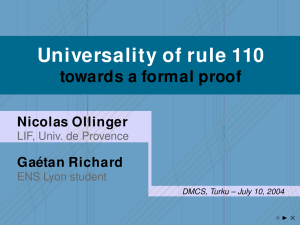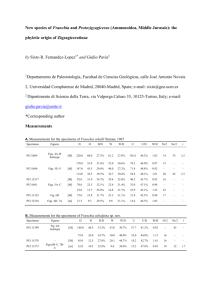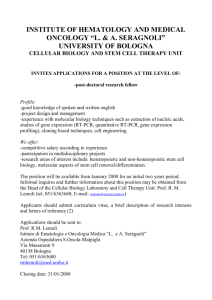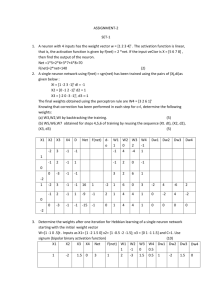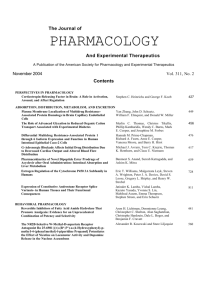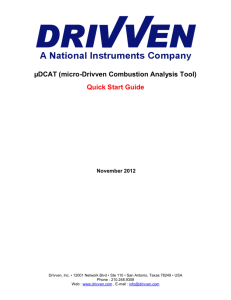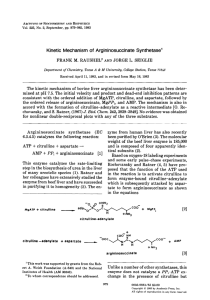StarLogo Simulation of Streaming Aggregation Demonstration of StarLogo Simulation of Streaming
advertisement
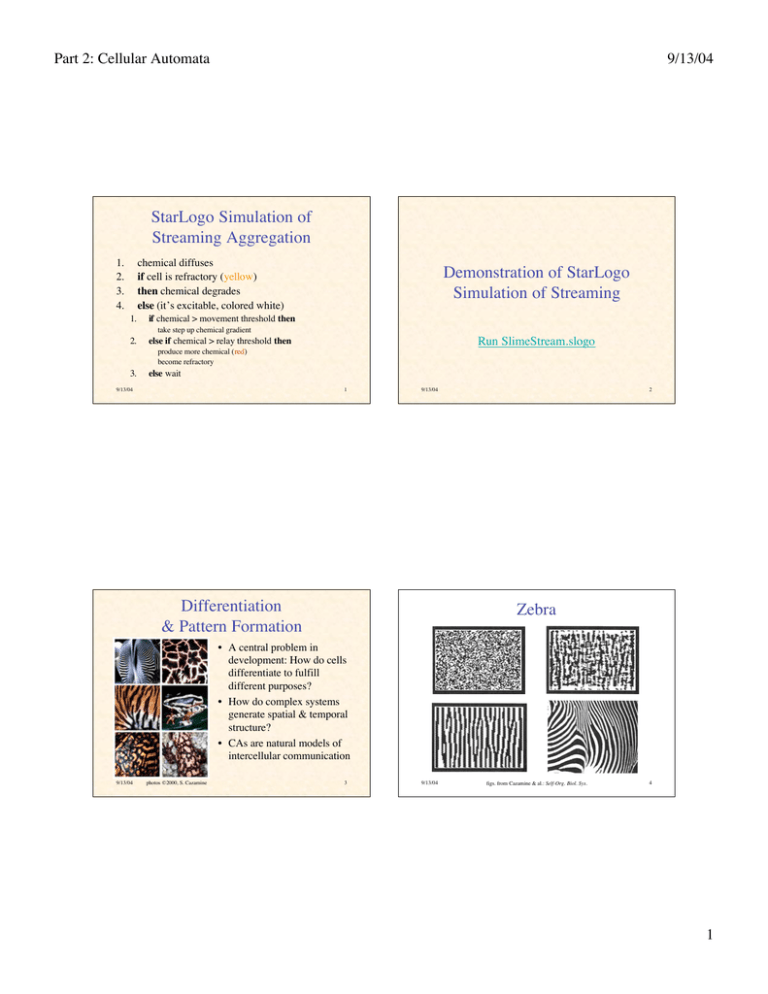
Part 2: Cellular Automata
9/13/04
StarLogo Simulation of
Streaming Aggregation
1.
2.
3.
4.
chemical diffuses
if cell is refractory (yellow)
then chemical degrades
else (it’s excitable, colored white)
1.
if chemical > movement threshold then
2.
else if chemical > relay threshold then
Demonstration of StarLogo
Simulation of Streaming
take step up chemical gradient
Run SlimeStream.slogo
produce more chemical (red)
become refractory
3.
else wait
9/13/04
1
9/13/04
Differentiation
& Pattern Formation
2
Zebra
• A central problem in
development: How do cells
differentiate to fulfill
different purposes?
• How do complex systems
generate spatial & temporal
structure?
• CAs are natural models of
intercellular communication
9/13/04
photos ©2000, S. Cazamine
3
9/13/04
figs. from Cazamine & al.: Self-Org. Biol. Sys.
4
1
Part 2: Cellular Automata
9/13/04
Vermiculated Rabbit Fish
Activation & Inhibition
in Pattern Formation
• Color patterns typically have a characteristic length scale
• Independent of cell size and animal size
• Achieved by:
– short-range activation local uniformity
– long-range inhibition separation
9/13/04
figs. from Cazamine & al.: Self-Org. Biol. Sys.
5
9/13/04
6
Interaction Parameters
Emergent Hierarchical Structure
• Characteristic length
scale
• Independent of cell
size and space size
• Structures created at
intermediate level
• R1 and R2 are the interaction ranges
• J1 and J2 are the interaction strengths
9/13/04
7
9/13/04
8
2
Part 2: Cellular Automata
9/13/04
Example
CA Activation/Inhibition Model
•
•
•
•
(R1=1, R2=6, J1=1, J2=–0.1, h=0)
Let states si {–1, +1}
and h be a bias parameter
and rij be the distance between cells i and j
Then the state update rule is:
si ( t + 1) = signh + J1 s j ( t ) + J 2 s j ( t )
rij <R1
R1 <rij <R 2
9/13/04
9
figs. from Bar-Yam
9/13/04
Effect of Bias
Effect of Interaction Ranges
(h = –6, –3, –1; 1, 3, 6)
R2 = 8
R1 = 1
h=0
R2 = 6
R1 = 1
h=0
R2 = 6
R1 = 1.5
h=0
9/13/04
figs. from Bar-Yam
10
11
9/13/04
R2 = 6
R1 = 1.5
h = –3
figs. from Bar-Yam
12
3
Part 2: Cellular Automata
9/13/04
Digression on Diffusion
Differential Interaction Ranges
• Simple 2-D diffusion equation:
• How can a system using strictly local
interactions discriminate between states at
long and short range?
• E.g. cells in developing organism
• Can use two different morphogens diffusing
at two different rates
13
9/13/04
reaction
14
0 2 A f A ( A,I )
+
dI 2 I f I ( A,I ) • Let be the logistic sigmoid function
• Activator A and inhibitor I may diffuse at
different rates in x and y directions
• Cell is “on” if activator + bias exceeds
inhibitor
A
2A
2A
= dAx 2 + dAy 2 + k A [ mA ( A + B I )]
t
x
y
A
c˙ = D 2c + f (c), where c = I
9/13/04
2 A( x, y ) 2 A( x, y )
+
x 2
y 2
Example:
Activation-Inhibition System
Reaction-Diffusion System
A d A
=
t I 0
2 A( x, y ) =
– positive in a local minimum
– negative in a local maximum
9/13/04
diffusion
• Recall the 2-D Laplacian:
• The Laplacian (like 2nd derivative) is:
– activator diffuses slowly (short range)
– inhibitor diffuses rapidly (long range)
A
= dA 2 A + f A ( A,I )
t
I
= dI 2 I + f I ( A,I )
t
A˙ ( x, y ) = c 2 A( x, y )
I
2I
2I
= dIx 2 + dIy 2 + k I [ mI ( A + B I)]
t
x
y
15
9/13/04
16
4
Part 2: Cellular Automata
9/13/04
Demonstration of StarLogo
Program for Activation/Inhibition
Pattern Formation
Run Pattern.slogo
9/13/04
17
Abstract Activation/Inhibition
Spaces
• Consider two axes of cultural preference
– E.g. hair length & interpersonal distance
– Fictitious example!
• Suppose there are no objective reasons for
preferences
• Suppose people approve/encourage those with
similar preferences
• Suppose people disapprove/discourage those with
different preferences
• What is the result?
9/13/04
18
A Key Element of
Self-Organization
Emergent Regions of Acceptable
Variation
• Activation vs. Inhibition
• Cooperation vs. Competition
• Amplification vs. Stabilization
• Growth vs. Limit
• Positive Feedback vs. Negative Feedback
– Positive feedback creates
– Negative feedback shapes
9/13/04
19
9/13/04
20
5
Part 2: Cellular Automata
9/13/04
Additional Bibliography
1.
2.
3.
4.
5.
6.
9/13/04
Kessin, R. H. Dictyostelium: Evolution, Cell Biology, and the
Development of Multicellularity. Cambridge, 2001.
Gerhardt, M., Schuster, H., & Tyson, J. J. “A Cellular Automaton
Model of Excitable Media Including Curvature and Dispersion,”
Science 247 (1990): 1563-6.
Tyson, J. J., & Keener, J. P. “Singular Perturbation Theory of
Traveling Waves in Excitable Media (A Review),” Physica D 32
(1988): 327-61.
Camazine, S., Deneubourg, J.-L., Franks, N. R., Sneyd, J.,
Theraulaz, G.,& Bonabeau, E. Self-Organization in Biological
Systems. Princeton, 2001.
Pálsson, E., & Cox, E. C. “Origin and Evolution of Circular Waves
and Spiral in Dictyostelium discoideum Territories,” Proc. Natl.
Acad. Sci. USA: 93 (1996): 1151-5.
Solé, R., & Goodwin, B. Signs of Life: How Complexity Pervades
Biology. Basic Books, 2000.
continue to “Autonomous Agents”
21
6
